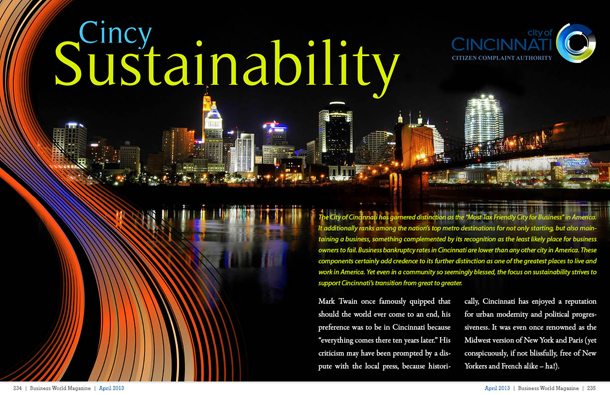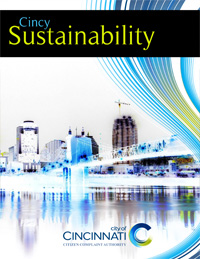
Cincy Sustainability

The City of Cincinnati has garnered distinction as the “Most Tax Friendly City for Business†in America. It additionally ranks among the nation’s top metro destinations for not only starting, but also maintaining a business, something complemented by its recognition as the least likely place for business owners to fail. Business bankruptcy rates in Cincinnati are lower than any other city in America. These components certainly add credence to its further distinction as one of the greatest places to live and work in America. Yet even in a community so seemingly blessed, the focus on sustainability strives to support Cincinnati’s transition from great to greater.
Mark Twain once famously quipped that should the world ever come to an end, his preference was to be in Cincinnati because “everything comes there ten years later.†His criticism may have been prompted by a dispute with the local press, because historically, Cincinnati has enjoyed a reputation for urban modernity and political progressiveness. It was even once renowned as the Midwest version of New York and Paris (yet conspicuously, if not blissfully, free of New Yorkers and French alike – ha!).
And in terms of strategies for sustainability; that is, adopting practices to reduce its carbon footprint and operate with greater eco-sensitivity, Cincinnati started blazing a trail while some communities were still struggling to find a path. The city had established an Office of Environmental Management more than twenty years ago which sought solutions to the future and benefitted from support of city leadership, but in 2003, budget problems combined with political tensions and turnover to see that office and all its potential, suddenly eliminated.
A little over two years later, in his campaign for City Mayor, Mark Mallory (a former Member of the Ohio House of Representatives and Ohio State Senate) ran on a platform that pledged to restore the office. After winning the election, he fulfilled that promise and established what is recognized today as Cincinnati’s Office of Environmental Quality. That decision has not only helped reduce annual city operational costs in the millions of dollars, but has also led to new jobs and greater potential for the city to reap further benefits vital to its future.
Cursed by its Blessing
Larry Falkin, the Director of Cincinnati’s Office of Environmental Quality, says to truly talk sustainability, one must understand that it is “a place-based discussion.†He says local issues, the local facts on the ground, dictate that sustainability never means the same thing or works the same way from one place to the next. And when it comes to sustainability strategies in Cincinnati, Falkin says it is a community that is almost cursed by its blessings. To put that in context, in many cases, a city’s move to greater sustainability practices may be prompted by critical concerns of energy supply, deterioration of water and air quality, or other less-than-desired environmental factors. However, none of these are so worrisome in Cincinnati. “We are a city that has cheap and abundant energy supplies credited to our proximity to the rich coal fields of West Virginia and Ohio. We have cheap and abundant landfills, which still have plenty of capacity. We also have cheap and abundant water supplies. Some places worry about their water usage, but our utility has never had to asked people to cut back due to drought. We also have cheap and abundant land, and there’s lots of new construction of single family homes selling for less than two hundred thousand dollars within an hour’s drive of downtown,†explains Falkin. So, with so much going in its favor, the conditions that might typically compel the concentration on sustainability do not exist as urgencies in Cincinnati. As Falkin asserts, that creates real challenge.
“How do you make recycling competitive when landfills are so cheap? How do you make the case for renewable energy when electricity is so cheap at five cents a kilowatt hour?†asks Falkin.
“And yet, we all know that sustainability is important. We’ve got to work hard to ensure whatever solutions we’re coming up with make economic sense. If the solutions don’t make economic sense, they won’t take hold,†he says.
Today, Falkin’s office has made strides that connote to good sense environmentally and economically. Efforts have included enhancement to the city’s recycling program which currently sees some 70% of eligible households participating. Residents are provided with wheeled-carts that are collected every second week, which has ultimately led to a 50% increase in materials diverted from landfills. The savings amount from $600,000 to $900,000 a year.
The city has also seen reduction in utility costs through retrofits, green building upgrades, and incorporation of energy generating solar power installations which currently exist on the roofs of two dozen city buildings. The city is currently expanding its portfolio of solar facilities, and Falkin says he anticipates this will enable Cincinnati to capture twice as much energy output over this year. The city has negotiated a 20-year deal with a company known as Solar Power and Light (SP&L). In a move that will not cost Cincinnati one red cent, SP&L plans to build, operate and maintain solar power facilities at its own expense. In turn, the city will purchase energy from SP&L at a cost that is less than what they now pay. “This enables us to better budget for future energy cost, is a hundred percent green, and even in Cincinnati where there is cheap coal, we can save money too,†says Falkin.
There are other benefits in the way of improving air quality. Granted, Cincinnati is free of conditions that plague communities from California and Texas to New York, but it too wrestles with issues unique to its environment. Abundant coal means abundance of energy generated from coal. Though companies employ what Falkin describes as “reasonably good†measures to control air pollution, it can still be done better. In fact, some plants are already relying more on a mix of fuel sources to supply energy, and that trend to increasingly rely less on carbon-based materials will continue. “Fifty and sixty years ago, making coal plants made a lot of sense, but today, with the alternatives we have, it doesn’t make as much sense as it once did,†says Falkin. With increased reliance on solar energy and less dependence on fossil fuels, Falkin says the improvements to air quality will also lead to fewer asthma rates, respiratory disorders and improved health for residents.
Transitional Triumphs
Cincinnati is also making improvements to its infrastructure in transportation and fleet operation, which again, will yield to less reliance on fossil fuels. Falkin says by 2025, the city “will be done with gas and diesel.†Over the last two years, the city fleet has reduced its gas consumption by more than 12 percent, which he calls progress toward that goal. The city is now utilizing more electric and hybrid-electric vehicles, but plans to acquire more fueled by cleaner, compressed-natural-gas and will soon begin developing CNG fueling stations.
 Other initiatives involve mass transportation. Although the city maintains a public bus system known as Metro, one initiative will lead to the establishing of a downtown modern street car system, similar to that which sparked redevelopment in Portland. The street cars will connect with downtown neighborhoods and will run on overhead electric power lines. The idea is to decrease downtown traffic congestion while increasing public ridership.
Increased ridership is also at play in the developing of a new bus rapid transit line that will begin this summer. To explain Cincinnati’s approach, Falkin offers a little insight into cultural aspects of transit.
“If you look at people who ride the bus and those who ride a train, you’ll notice they are not the same. Many people who ride the bus are transit dependent. They have no other way of getting around, and this is affordable, but also very important to their life. With those on the train, they ride it by choice because it is fast, spacious enough for them to do work while riding and convenient, but it is also expensive,†explains Falkin.
So, the trick is to get “train-like†performance from the bus in such a way that choice riders will want to use it as enthusiastically as those who really depend on it. To accomplish that, the bus will operate as an express or rapid transport, stopping only at major stops as opposed to every bus stop to allow for faster commuting. Secondly, passengers won’t have to pay fare as they get on the bus, but rather pay at the platform to better facilitate faster boarding. Passengers will also benefit from processes that allow for signal prioritization or what is known as “Cue-Jumping.†Basically, this means that the bus will communicate with traffic lights to get a faster green light for go signal and also have opportunities to bypass traffic congestion by accessing specialized lanes. “If you’re riding the bus, you’ll be able to get where you need to go faster than driving your own car,†says Falkin.
At present, 20 percent of Cincinnati residents do not have access to cars. Falkin says the new system will provide greater convenience to public transit passengers, but is another important step in the city’s drive for increased sustainability.
Through its focus on sustainability, Cincinnati has also fostered the growth of professional partnership and environmental initiatives that ultimately benefit economic development vital to the region. Among these initiatives, what Falkin calls “an important partnership,†is Agenda 360. Facilitated by the Cincinnati Chamber of Commerce, Agenda 360 strives to develop a set of priorities for the region to successfully compete for business, attract employees and generate economic growth. Falkin says the initiative embraces the idea that being a sustainable city or a green city is vital to that effort. The city has also supported another program known today as “Green Umbrella,†an effort that has led to a network of more than 200 member groups all working together to focus, and foster, sustainability practices.
There are many other initiatives underway, or in the works, but suffice it to say that Cincinnati is implementing changes to allow for greater efficiency tomorrow. For a community famed for certain shades of Bengal-orange and Cincinnati Red, the future holds greater hues of green.
For more information, please visit their website at: Â City of Cincinnati








